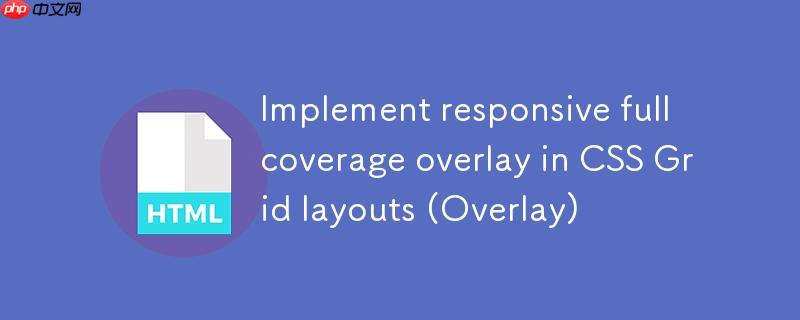
在现代网页布局中,使用 CSS Grid 构建复杂且响应式的界面已成为常态。然而,当需要在 Grid 布局中的某个特定区域(例如一个 grid-area 定义的 main-container)之上创建一个全覆盖的叠加层(Overlay),并且要求这个叠加层能够完美适应父容器的大小变化时,开发者常常会遇到挑战。
常见的尝试包括:
这些方法都无法在不设定固定尺寸的前提下,让叠加层精确地覆盖其 Grid 布局中的父容器,尤其是在需要保持布局响应式时。
要解决上述问题,关键在于理解 position: absolute 的定位机制,并为其提供一个明确的定位上下文。CSS 中的 position: absolute 元素会脱离文档流,并相对于其最近的已定位祖先元素(即 position 属性值不为 static 的祖先元素)进行定位。
立即学习“前端免费学习笔记(深入)”;
因此,解决方案的核心在于:
通过这种组合,叠加层会相对于其设置为 position: relative 的父容器进行定位和尺寸计算,从而实现精确的全覆盖效果,且无需担心父容器尺寸的变化,天然支持响应式布局。
下面通过一个具体的代码示例,演示如何在 CSS Grid 布局中为一个 main-container 区域添加一个响应式的全覆盖叠加层。
我们有一个包含导航栏(navbar)、主内容区域(main-container)和页脚(footer)的 Grid 布局。main-container 内部又是一个 Grid 布局,包含三个子元素。叠加层 .modal 直接作为 main-container 的子元素。
<div id="containers">
<div id="navbar-container"></div>
<div id="main-container">
<div id="child1">
<span>CHILD 1</span>
</div>
<div id="child2">
<span>CHILD 2</span>
</div>
<div id="child3">
<span>CHILD 3</span>
</div>
<!-- 叠加层元素 -->
<div class="modal">
MODAL
</div>
</div>
<div id="footer-container"></div>
</div>关键在于 #main-container 设置 position: relative; 和 .modal 设置 position: absolute; width: 100%; height: 100%;。
#containers {
display: grid;
/* 定义主网格区域:navbar 和 main 在第一行,navbar 和 footer 在第二行 */
grid-template-areas: "navbar main" "navbar footer";
/* 定义行高:第一行占大部分,第二行固定32px */
grid-template-rows: calc(100% - 32px) 32px;
/* 定义列宽:第一列固定56px,第二列占剩余空间 */
grid-template-columns: 56px calc(100% - 56px);
/* 确保容器占据整个视口高度,以便内部百分比高度生效 */
height: 100vh; /* 或者父级有明确高度 */
}
#navbar-container {
grid-area: navbar;
background-color: blue;
}
#main-container {
grid-area: main;
height: 100%;
width: 100%;
display: grid;
/* 定义 main-container 内部的网格布局 */
grid-template-areas:
'child1 child2'
'child1 child3';
grid-template-columns: 1fr 1fr;
grid-template-rows: 1fr 1fr;
/* 核心:为叠加层提供定位上下文 */
position: relative;
}
#footer-container {
grid-area: footer;
background-color: black;
}
#child1,
#child2,
#child3 {
padding: 10px;
}
#child1 {
grid-area: child1;
background-color: red;
}
#child2 {
grid-area: child2;
background-color: purple;
}
#child3 {
grid-area: child3;
background-color: pink;
}
.modal {
/* 核心:绝对定位,覆盖整个父容器 */
width: 100%;
height: 100%;
position: absolute;
top: 0; /* 确保从父容器顶部开始 */
left: 0; /* 确保从父容器左侧开始 */
background-color: grey;
opacity: 0.5; /* 半透明效果 */
/* 可选:设置 z-index 确保叠加层在最上层 */
z-index: 10;
display: flex; /* 方便叠加层内部内容居中 */
justify-content: center;
align-items: center;
color: white;
font-size: 2em;
}通过上述代码,.modal 叠加层将精确地覆盖 #main-container 区域,无论 #main-container 的尺寸如何因响应式布局而变化,叠加层都会随之调整。
在 CSS Grid 布局中创建响应式全覆盖叠加层,最健壮且推荐的方法是利用 position: relative 和 position: absolute 的组合。通过将父容器设置为 position: relative 来建立定位上下文,然后将叠加层设置为 position: absolute 并配合 width: 100%; height: 100%; top: 0; left: 0;,可以确保叠加层精确覆盖父容器,同时保持出色的响应性和灵活性。这种技术是构建复杂、动态且用户友好的 Web 界面的基石。
以上就是CSS Grid 布局中实现响应式全覆盖叠加层(Overlay)的详细内容,更多请关注php中文网其它相关文章!

每个人都需要一台速度更快、更稳定的 PC。随着时间的推移,垃圾文件、旧注册表数据和不必要的后台进程会占用资源并降低性能。幸运的是,许多工具可以让 Windows 保持平稳运行。

Copyright 2014-2025 https://www.php.cn/ All Rights Reserved | php.cn | 湘ICP备2023035733号